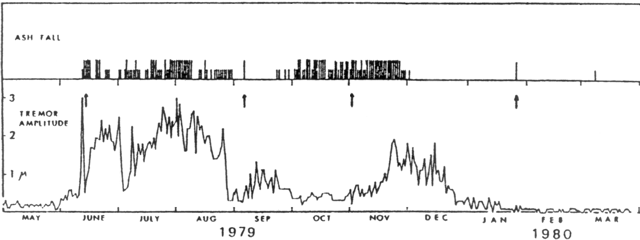Report on Asosan (Japan) — April 1980
Scientific Event Alert Network Bulletin, vol. 5, no. 4 (April 1980)
Managing Editor: David Squires.
Asosan (Japan) Small ash emission
Please cite this report as:
Global Volcanism Program, 1980. Report on Asosan (Japan) (Squires, D., ed.). Scientific Event Alert Network Bulletin, 5:4. Smithsonian Institution. https://doi.org/10.5479/si.GVP.SEAN198004-282110
Asosan
Japan
32.8849°N, 131.085°E; summit elev. 1592 m
All times are local (unless otherwise noted)
A weak and brief emission of ash from Aso occurred on 8 March, producing ashfall on the S flank. Since strong ash emission stopped on 28 November 1979, eruptive activity had been confined to ejection of a small amount of ash and scoria, accompanied by a strong air and ground shock, on 26 January, and emission of white vapor at other times.
The amplitude of continuous tremor recorded at [Asosan Weather Station] declined in December 1979 and has remained low through March (figure 5). The number of local earthquakes increased somewhat around the January tephra ejection, but declined in February and did not increase substantially during the March activity.
Geological Summary. The 24-km-wide Asosan caldera was formed during four major explosive eruptions from 300,000 to 90,000 years ago. These produced voluminous pyroclastic flows that covered much of Kyushu. The last of these, the Aso-4 eruption, produced more than 600 km3 of airfall tephra and pyroclastic-flow deposits. A group of 17 central cones was constructed in the middle of the caldera, one of which, Nakadake, is one of Japan's most active volcanoes. It was the location of Japan's first documented historical eruption in 553 CE. The Nakadake complex has remained active throughout the Holocene. Several other cones have been active during the Holocene, including the Kometsuka scoria cone as recently as about 210 CE. Historical eruptions have largely consisted of basaltic to basaltic andesite ash emission with periodic strombolian and phreatomagmatic activity. The summit crater of Nakadake is accessible by toll road and cable car, and is one of Kyushu's most popular tourist destinations.
Information Contacts: JMA.


